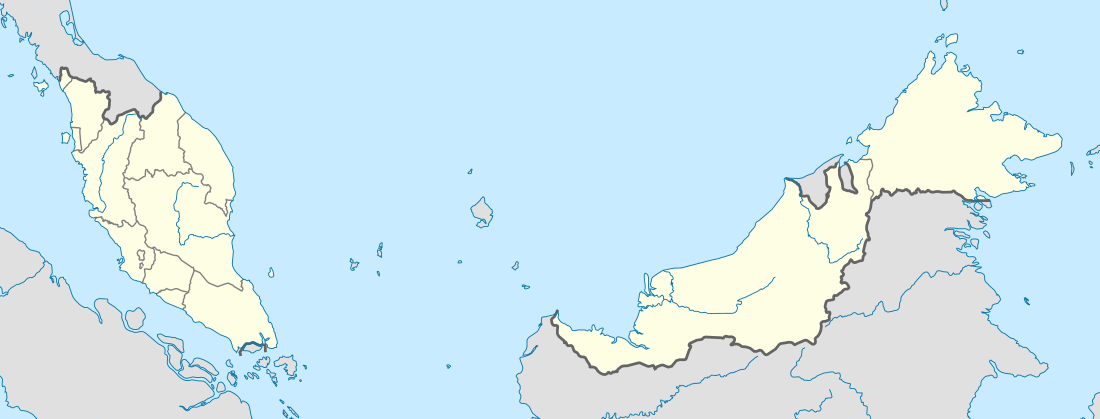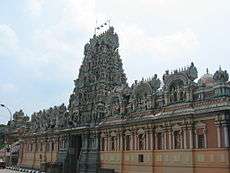Brickfields
Coordinates: 3°3′27.99″N 101°45′1.84″E / 3.0577750°N 101.7505111°E
| Brickfields | |
|---|---|
|
Jalan Tun Sambanthan in Brickfields. | |
 Brickfields Location within Malaysia | |
| Coordinates: 3°7′47″N 101°41′3″E / 3.12972°N 101.68417°E | |
| Country | Malaysia |
| Federal Territory | Kuala Lumpur |
| Constituency | Lembah Pantai |
| Government | |
| • Local Authority | Dewan Bandaraya Kuala Lumpur |
| • Mayor | Mhd Amin Nordin Abdul Aziz |
| Time zone | MST (UTC+8) |
| Postcode | 50470 |
| Dialling code | +60 322 |
| Police | Travers, Brickfields |
| Fire | Pantai, Central |
Brickfields is a small to medium-sized town and residential neighbourhood (as well as an administrative zone) located just outside central Kuala Lumpur, Malaysia. It is known as Kuala Lumpur's Little India due to the high percentage of Indian residents and businesses. Brickfields been ranked third in Airbnb’s list of top trending destinations.[1]
History

In 1881, a flood swept through Kuala Lumpur, in the wake of a disastrous fire. These successive problems destroyed the town's structures of wood and atap (thatching). As a response, Frank Swettenham, the British Resident of Selangor, required that buildings be constructed of brick and tile.[2] Hence, Kapitan Yap Ah Loy bought a sprawling piece of real estate for the setting up of a brick industry which would spur the rebuilding of Kuala Lumpur. This place is the eponymous Brickfields.
Later the area was developed by Yap Kwan Seng, the fifth and last Kapitan Cina of Kuala Lumpur. As a businessman, he foresaw an increased demand for bricks in fast-growing Kuala Lumpur and established a kiln in the district. The area soon became the centre for brick-making in the early days because the whole area was a clay pit and good quality bricks are made from clay. Therefore, Brickfields became synonymous with good quality bricks.
Brickfields also used to be the site of the main depot for Keretapi Tanah Melayu (KTM) (Malayan Railway) during the administration of the British. The British authorities brought in people from Sri Lanka to work the railway and the depot. Many lived in quarters around Brickfields. Since then the Indian community have lived and remained here and became citizens of Malaysia. Some of the old quarters can still be found around Jalan Rozario. Today the depot has been transformed into KL Sentral, the main railway hub of the city.
Brickfields is one of the pioneer settlements in Kuala Lumpur. Indeed, the whole stretch of Jalan Tun Sambanthan (formerly Jalan Brickfields) is interspersed with old colonial structures.
Lifestyle
Culture

Along Jalan Tun Sambanthan 4 is the century old Young Men's Christian Association (YMCA), which has become an integral landmark in Brickfields. Further down along Jalan Tun Sambanthan is the charming Vivekananda Ashramam that was built in the early 19th century.
Brickfields also houses historical government quarters built during the British era which are under harm from rapid development. The 100 railway quarters in Jalan Rozario are still there although modern buildings have cropped up all around. The "Hundred Quarters" are located at Jalan Chan Ah Tong. It was built in 1915 as terrace houses for junior servants. It is planned to be demolished for commercial development. As of June 2014 there has been no demolition works.
Brickfields is popular for its Indian food delights especially the unique banana leaf rice and thosai (Indian pancake made from fermented rice flour).
The Malaysian Association for the Blind (MAB), located along Jalan Tebing, houses a number of blind people. They can be seen walking around Brickfields. Many have become familiar with the area that they rarely encounter much problem walking around here. Most parts of Brickfields have been equipped with tactile guided pathways designed to aid the blind in walking around the area.
The Temple of Fine Arts is located along Jalan Berhala. It is essentially a cultural organisation offering various courses relating to mainly Southern Indian music, dance, and arts. It was founded in 1981 and has currently similar centers in Johor Bahru, Melaka, Penang, as well as centers around the world including India, Australia and Singapore. Besides offering courses, the organisation frequently organises Indian performances around Kuala Lumpur, and has produced many artists progressing to international standards.. They will be launching their state of art building soon which has been built upon the founding architecture old Temple of Fine Arts adjacent to the Maha Vihara Buddhist Temple. The new building will be symbolic icon to the progress of arts and culture in Brickfields.
Religion



Brickfields is also tagged as a "Divine Location" as many religious structures, some over 100 years old, are concentrated in the area, particularly Jalan Berhala. The aptly named road ("Berhala" means shrine) houses the Buddhist Maha Vihara Temple and the Sri Sakthi Karpaga Vinayagar Temple.
The Sri Kandaswamy Temple is one of the most prominent Sri Lankan Tamil or Ceylonese Tamil temple located along Jalan Scott. It is huge and showcases rich Tamil Architecture and has become a popular tourist attraction in Kuala Lumpur. This temple was built in 1902. They provide religious services such as house warming ceremonies and child 31st day ceremony. The Kalamandapam hall which was officiated by the 2nd Prime Minister of Malaysia holds wedding ceremonies and is also owned by this temple.
Both the Sri Kandaswamy Temple and Buddhist Maha Vihara Temple stand testament to the influence of the Ceylonese in Brickfields, who were brought in to work on the Malayan Railways before World War II.
A sprinkling of churches of different denominations can also be found here. Among the larger churches in the area are the Holy Rosary Church (est. 1903), Our Lady of Fatima, and the Zion Lutheran Church. Most of which are located along Jalan Sultan Abdul Samad. There is also an Indian orthodox church called the St. Mary's Orthodox Syrian Cathedral in Jalan Tun Sambanthan Satu.
There is a Surau (small mosque) located on Jalan Sultan Abdul Samad called Madrasatul Gouthiyyah. This mosque is mainly attended by Indian-Muslims, and the sermons are sometimes conducted in Tamil. Finally, another major landmark in Brickfields is the 50-year-old Three Teachings Chinese Temple along Jalan Thambillay.
Trade
Being the Little India of Kuala Lumpur, it has numerous shops that are owned by Indian businessmen. There are spice shops, grocery outlets, sweet and snacks shops, textile shops, goldsmiths, hotels, restaurants, food stalls, printers and even flower stalls.
The headquarters of Malaysian Institute of Accountants can be found along Jalan Tun Sambanthan 3, which also contains a number of second tier audit firms scattered around. There are also plenty of law firms all over Brickfields area.
Other popular businesses here is the printing and paper distribution business which is concentrated along Jalan Sultan Abdul Samad.
The new Sentral Brickfields 3-storey commercial complex is located next to the sri kandaswamy temple offering 22 exclusive retail outlets with free parking and easy access via the Jalan Istana road. The new Sonali business showroom is located in this building. The tagline for Sentral Brickfields is The Riverside Family Center In Little India http://www.sentralbrickfields.asia
Infrastructure and Facilities
Police Station
The Brickfields police station closed end of 2010 and was temporarily relocated to Sri Petaling. The Brickfields District Police is one of the four police district headquarters in Kuala Lumpur. Its jurisdiction covers, among others, the area of Bangsar, Bukit Damansara, Taman Tun Dr Ismail, Taman Desa, Jalan Klang Lama, and Sri Petaling.[3]
Schools
There are many schools located at Brickfields.
Secondary schools:
- SMK Vivekananda,Brickfields
- SMK La Salle School, Brickfields
Primary schools:
- SK La Salle Brickfields 1 & 2
- SK Brickfields 1 & 2
- SK. ST. THERESA (1) & (2)
- Methodist Girls School (MGS KL) 1 & 2
- SRJK (T) Vivekananda
- SRJK (C) St Theresa
- SRJK (C) La Salle
Private schools:
Colleges:
Cultural/Social Organisations
- YMCA
- Temple of Fine Arts
- Malaysian Association of the Blind (MAB)
- Rukun Tetangga Sektor Brickfields - A government base social body for Brickfields residents.
- The Society For Deaf In Selangor And Federal Territory - A civil rights organization for deaf and hard of hearing individuals. Formed in 1975.
Development
Brickfields is rapidly evolving from being a residential to a very commercial extension of downtown Kuala Lumpur. The KL Sentral development project is one of Kuala Lumpur's largest development project encompassing an area of 290,000 square metres. It includes the KL Sentral transportation hub, two hotels, condominiums, shopping complexes, a clubhouse, office buildings, as well as a convention and entertainment centre. Much of it is built on the former Keretapi Tanah Melayu marshalling yard here in Brickfields. The overall project is expected to be completed in 2012.
The rapid evolvement has left parts of Brickfields suspended in time. One can find small village type housing amidst the high-rise modern living complexes being constructed. There has been efforts to clean up the area of Brickfields outside the KL Sentral development area. Recently Brickfields' image as a notorious area with a high incidence of crime is slowly disappearing. There is also a few rows of shophouses at Jalan Thambipillay where prostitutes ply their trade.
Transport

Brickfields can be accessed through many ways:
- KL Monorail: Tun Sambanthan and KL Sentral stations
- Rapid KL's Kelana Jaya Line (LRT): KL Sentral station
- KTM Komuter: KL Sentral station
- Express Rail Link: KL Sentral station
- Rapid KL buses
The combination of the commercial activity, schools and residential traffic and Brickfields' location as one of the major access points into and out the city frequently results in bad traffic congestion in the mornings and evenings.
Prominent Personalities
- Ananda Krishnan, one of Malaysia and South East Asia's richest men grew up in Brickfields and studied at the Vivekananda Tamil school.
- Bastianpillai Paul Nicholas, Malaysia's first Asian banker.
- Tan Sri Devaki Krishnan, the first Malaysian woman to stand for election.
References
- ↑ \http://www.themalaysianinsider.com/citynews/greater-kl/article/brickfields-ranks-third-in-global-trending-destinations/brickfields-ranks-third-in-global-trending-destinations#sthash.GBVWCRRx.dpuf
- ↑ "Kuala Lumpur". Encyclopædia Britannica. Retrieved 2007-12-06.
- ↑ Direktori, Polis Diraja Malaysia. Accessed April 10, 2007.
Further reading
Baxstrom, Richard (2008). Houses in Motion: The Experience of Place and the Problem of Belief in Urban Malaysia. Stanford: Stanford University Press. 304 pp. ISBN 9780804758918.
Baxstrom, Richard (2010). Transforming Brickfields: Development and Governance in a Malaysian City. Singapore: National University of Singapore Press. 283 pp. ISBN 9971694948.
Moses, Balan (2007). Brickfields: A Place, A Time, A Memory. Kuala Lumpur. 207 pp. ISBN 9789834150525.
Willford, Andrew (2006). Cage of Freedom: Tamil Identity and the Ethnic Fetish in Malaysia. Ann Arbor: University of Michigan Press. 360 pp. ISBN 9780472069569.
External links
| Wikimedia Commons has media related to Brickfields. |
-
 Brickfields travel guide from Wikivoyage
Brickfields travel guide from Wikivoyage - Tourism Malaysia - Little India Brickfields

